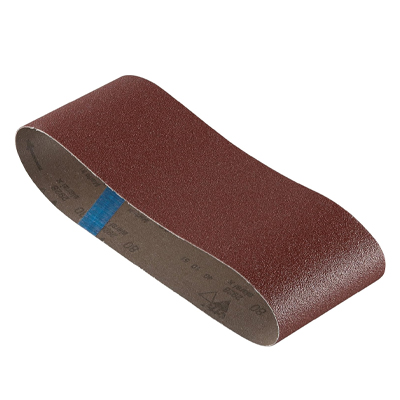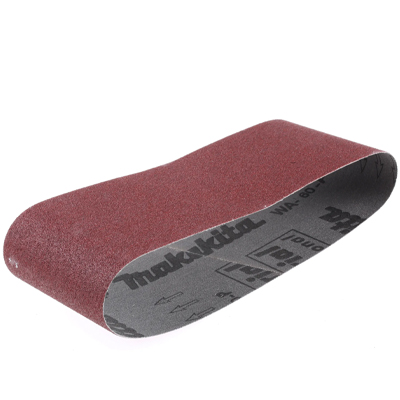Sanding Belts
Buy Best Sanding Belts are indispensable tools in the realm of material finishing and surface preparation. These flexible, durable belts consist of an abrasive material wrapped around a continuous loop, creating a highly effective abrasive surface. That can be affixed to various sanding machines like belt sanders. Sanding belts come in an assortment of abrasive grits, making them suitable for a wide spectrum of applications. Coarser grits are perfect for rapid material removal, smoothing rough surfaces, and shaping wood or metal, while finer grits excel in achieving a polished, smooth finish on surfaces and for fine detail work.
When it comes to sanding belts, we understand that quality, durability, and performance are essential factors in achieving outstanding results. Our selection of sanding belts is curated to meet the needs of both professionals and DIY enthusiasts. Crafted from high-quality abrasive materials, our sanding belts are built to withstand rigorous use and deliver consistent, smooth finishes on various surfaces. With a variety of grit options available, you can find the perfect belt to suit your specific sanding needs, whether you're tackling wood, metal, or other materials. Design for compatibility with a wide range of belt sanders, our belts are easy to install and ensure efficient material removal while minimizing heat buildup. Trust in our sanding belts to help you achieve exceptional results in your projects, making your sanding tasks more efficient and effective. Buy Best Sanding Belts, Explore our range today to elevate your sanding experience to the next level.
Types of Sanding Belts
Aluminum Oxide Sanding Belts:
Aluminum oxide sanding belts are among the most commonly use types. They feature a versatile abrasive grain that offers good durability and cutting efficiency. These belts are ideal for general-purpose sanding tasks on materials like wood, metal, and plastics. They excel at removing surface imperfections, smoothing rough edges, and preparing surfaces for painting or finishing.
Zirconia Alumina Sanding Belts:
Zirconia alumina sanding belts are known for their exceptional durability and heat resistance. They are particularly well-suited for heavy-duty applications, such as metal grinding and shaping. Zirconia alumina abrasives maintain their sharpness and cutting ability even at high temperatures, making them a top choice for professionals in the metalworking and welding industries.
Ceramic Sanding Belts:
Ceramic sanding belts are engineered for extreme durability and longevity. They are design to outlast other abrasives, making them cost-effective for high-volume or continuous sanding applications. Ceramic abrasives are commonly use in metalworking, particularly for grinding and shaping hardened steel, stainless steel, and other tough alloys.
Silicon Carbide Sanding Belts:
Silicon carbide sanding belts are preferred for sanding non-ferrous metals, glass, ceramics, and stone surfaces. They are known for their excellent abrasion resistance and ability to maintain their sharpness in wet or dry sanding conditions. These belts are often use for applications like glass edge finishing, stone polishing, and deburring of non-metallic materials.
Non-Woven Sanding Belts:
Non-woven sanding belts are unique in that they do not rely on abrasive grains. They use a web-like structure made of nylon fibers impregnated with abrasive materials. These belts are gentle on surfaces, making them suitable for blending, cleaning, and deburring delicate materials like stainless steel, aluminum, and composites. They are also commonly use for surface conditioning and preparation.
Film-backed Sanding Belts:
Film-backed sanding belts feature a flexible and tear-resistant polyester film as the backing material. This design allows for precise sanding and contouring of curved or intricate surfaces. Film-backed belts are often use in fine woodworking, automotive finishing, and applications where a smooth, scratch-free finish is critical. They are compatible with both dry and wet sanding techniques.
Top Brands of Sanding Belts
Norton Abrasives (Saint-Gobain Abrasives):
Norton Abrasives, a division of Saint-Gobain Abrasives, is a globally renown brand with a strong presence in the UK. They offer a comprehensive range of sanding belts designed for various materials and applications. Norton's sanding belts are known for their durability, consistent performance, and innovative designs. Where you're working on wood, metal, or other materials, Norton Abrasives provides a reliable choice for achieving smooth and precise finishes.
3M Abrasives:
3M is a multinational conglomerate known for its diversified product portfolio. Their sanding belts are no exception. 3M Abrasives deliver cutting-edge solutions for a wide range of applications, from woodworking to metalworking. Their sanding belts are design to offer superior performance, longevity, and versatility. With a focus on innovation, 3M continues to develop advanced sanding belt technologies that enhance efficiency and produce high-quality results.
Mirka Abrasives:
Mirka, a Finnish-based brand, has gained a strong foothold in the UK market for sanding solutions. They are known for their innovative sanding products, including the popular Mirka Abranet sanding belts. Mirka's sanding belts stand out for their dust-free sanding capabilities, which improve both efficiency and workplace safety. These belts are favore by professionals in woodworking, automotive refinishing, and marine industries.
Klingspor:
Klingspor is a well-established abrasive brand originating from Germany but widely available in the UK. They offer a diverse range of sanding belts tailored to various applications, including woodworking, metalworking, and surface preparation. Klingspor is recogniz for its commitment to quality control and research, ensuring that their sanding belts deliver consistent performance and longevity, making them ideal for demanding industrial settings.
Flexovit:
Flexovit, also part of the Saint-Gobain Abrasives group, is a brand that has been providing high-performance abrasives in the UK for decades. They offer a wide selection of sanding belts suitable for metal, wood, and composite materials. Flexovit is known for its dedication to quality and consistency, making their sanding belts a reliable choice for professionals in metal fabrication, construction, and woodworking.
SIA Abrasives:
SIA Abrasives is a Swiss-based brand that has established a strong presence in the UK market. They are known for producing high-quality sanding belts with a focus on durability and precision. SIA's sanding belts are design to meet the demands of professional craftsmen and industrial applications, providing excellent results on various materials, including wood, metal, and paint surfaces.
Uses of Sanding Belts
Woodworking:
Sanding belts are indispensable in woodworking for tasks such as surface preparation, stock removal, and finishing. They help in smoothing rough lumber, eliminating imperfections, and achieving a fine, polished surface. Whether in professional furniture making or DIY projects, sanding belts contribute to the precision and quality of the final woodwork.
Metalworking:
Sanding belts are essential tools in metalworking, where they play a crucial role in deburring, shaping, and polishing metal components. These belts are use to remove sharp edges, burrs, and surface irregularities from machined or cut metal parts. Sanding belts contribute to achieving specific finishes and dimensions required in the metal manufacturing industry.
Automotive Refinishing:
Automotive professionals rely on sanding belts for refinishing tasks such as paint removal, surface leveling, and preparing surfaces for primer and paint applications. Sanding belts efficiently remove old paint, rust, and minor dents from vehicle bodies and components, ensuring a smooth and flawless surface for painting and restoration.
Cabinetry and Joinery:
In the construction and cabinetry industries, sanding belts are use to refine and prepare wooden surfaces for finishing. Whether it's sanding cabinet doors, wooden panels, or staircases, these belts help achieve consistent, smooth, and polished surfaces. They are instrumental in achieving the desired aesthetics and functionality of wooden structures.
Metal Fabrication:
Sanding belts are extensively use in metal fabrication shops for tasks like weld blending, surface grinding, and edge chamfering. They aid in smoothing and finishing welded joints, preparing metal surfaces for welding, and creating bevels or chamfers on metal edges. Sanding belts play a pivotal role in ensuring the quality and integrity of metal components.
DIY Home Improvement:
Sanding belts are also valuable tools for DIY enthusiasts tackling a variety of projects around the home. From refinishing old furniture to sanding down drywall seams or preparing surfaces for painting, sanding belts provide an efficient and effective means of achieving professional-level results. Their versatility makes them essential for DIY tasks of all kinds.
Benefits of Sanding Belts
Efficient Material Removal:
One of the primary advantages of sanding belts is their ability to efficiently remove material. Because these abrasive belts feature a continuous, rotating surface that delivers consistent and rapid material removal, significantly reducing the time and effort required for sanding and smoothing tasks. This efficiency is particularly valuable in high-volume production settings, where time savings directly impact productivity and cost-effectiveness.
Versatility:
Sanding belts are highly versatile and suitable for a wide range of materials, including wood, metal, plastics, composites, and more. Their adaptability makes them an indispensable tool in various industries, from woodworking and metalworking to automotive refinishing and construction. You need to shape, smooth, or refine surfaces, sanding belts are design to tackle diverse materials and applications.
Precision and Consistency:
Sanding belts offer precise control over material removal, ensuring uniformity in surface finishes. This precision is vital for achieving specific dimensions and desired surface textures, particularly in industries where accuracy is paramount, such as aerospace manufacturing and fine woodworking. The consistent results obtained with sanding belts contribute to the overall quality of finished products.
Fast Stock Removal:
Sanding belts excel at removing stock or excess material quickly. They are particularly effective when leveling surfaces or reducing thickness, making them essential for tasks like leveling uneven wooden floors, smoothing rough metal welds, or preparing metal surfaces for welding. This fast stock removal capability enhances productivity and reduces labor costs in various applications.
Wide Grit Range:
Sanding belts are available in a wide range of grit sizes, from coarse to fine. Because variety allows users to perform both aggressive material removal and fine finishing with the same tool. Coarse grits are suitable for heavy stock removal, while finer grits produce smoother, polished surfaces. The ability to switch between grits on the same machine offers convenience and flexibility in sanding operations.
Cost-Effective:
Sanding belts are inexpensive tools because of their durability and lifespan. Buy design to withstand the rigors of industrial use, making because them an economical choice for professionals and businesses. Their long lifespan reduces the frequency of replacements, leading to cost savings over time. Where abrasive wear is a concern.







